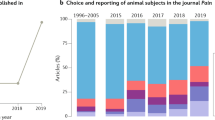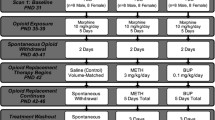Abstract
Rationale
Sex differences in the analgesic effects of mu-opioid agonists have been documented extensively in rodents and, to a lesser extent, in non-human primates. To date, there have been few experimental studies investigating this effect in humans, and the conclusions have been equivocal.
Objectives
The aims of the present study were to examine potential sex differences in the analgesic, subjective, performance, and physiological effects of morphine in human research volunteers.
Methods
Using a double-blind outpatient procedure, the present study investigated the effects of intramuscular morphine (0, 5, and 10 mg/70 kg, i.m.) in men (N = 8) and women (N = 10). The primary dependent measure was analgesia, as assessed by the cold pressor and mechanical pressure tests. Secondary dependent measures included subjective, performance, and physiological effects of morphine, as well as plasma levels of morphine.
Results
No differences in the analgesic and performance effects of morphine were observed between men and women, but significant differences in morphine’s subjective effects were found. Specifically, men reported greater positive effects, whereas women reported greater negative effects after morphine administration.
Conclusions
These data suggest that, in humans, there are sex differences in the subjective mood-altering effects of morphine but, based on this limited sample, there is little evidence for sex differences in its analgesic effects.






Similar content being viewed by others
References
Barrett AC (2006) Low efficacy opioids: implications for sex differences in opioid antinociception. Exp Clin Psychopharmacol 14:1–11
Barrett AC, Smith ES, Picker MJ (2002) Sex-related differences in mechanical nociception and antinociception produced by mu- and kappa-opioid receptor agonists in rats. Eur J Pharmacol 452:163–173
Berdine JH, Nesbit SA (2006) Equianalgesic dosing of opioids. J Pain Palliative Pharmacother 20(4):79–84
Bijur PE, Esses D, Birnbaum A, Chang A, Schechter C, Gallagher EJ (2008) Response to morphine in male and female patients: analgesia and adverse events. Clin J Pain 24(3):192–198
Braida D, Gori E, Sala M (1994) Relationship between morphine and etonitazene-induced working memory impairment and analgesia. Eur J Pharmacol 271:497–504
Brennum J, Kjeldsen M, Jensen K, Jensen TS (1989) Measurements of human pressure-pain thresholds on fingers and toes. Pain 38:211–217
Cepeda MS, Farrar JT, Baumgarten M, Boston R, Carr DB, Strom BL (2003) Side effects of opioids during short-term administration: effect of age, gender, and race. Clin Pharmacol Ther 74:102–112
Chen AC, Dworkin SF, Haug J, Gehrig J (1989) Human pain responsivity in a tonic pain model: psychological determinants. Pain 37:143–160
Chesterton LS, Barlas P, Foster NE, Baxter GD, Wright CC (2003) Gender differences in pressure pain threshold in healthy humans. Pain 101:259–266
Chia YY, Chow LH, Hung CC, Liu K, Ger LP, Wang PN (2002) Gender and pain upon movement are associated with the requirements for postoperative patient-controlled iv analgesia: a prospective survey of 2, 298 Chinese patients. Can J Anaesth 3:249–255
Clark WC, Dillon DJ (1973) SDT analysis of binary decisions and sensory intensity ratings to noxious thermal stimuli. Percept Psychophys 13:491–493
Clark WC, Ferrer-Brechner T, Janal MN, Carroll JD, Yang JC (1989) The dimensions of pain: a multidimensional scaling comparison of cancer patients and healthy volunteers. Pain 37:23–32
Comer SD, Collins ED, MacArthur RB, Fischman MW (1999) Comparison of intravenous and intranasal heroin self-administration by morphine-maintained humans. Psychopharmacology 143:327–338
Conley KM, Toledano AY, Apelbaum JL, Zacny JP (1997) Modulating effects of a cold water stimulus on opioid effects in volunteers. Psychopharmacology 131:313–320
Craft RM (2003) Sex differences in drug- and non-drug-induced analgesia. Life Sci 72:2675–2688
Dahan A, Sarton E, Teppema L, Olievier C (1998) Sex-related differences in the influence of morphine on ventilatory control in humans. Anesthesiology 88:903–913
Darke S, Sims J, McDonald S, Wickes W (2000) Cognitive impairment among methadone maintenance patients. Addiction 95:687–695
Dixon KE, Thorn BE, Ward LC (2004) An evaluation of sex differences in psychological and physiological responses to experimentally-induced pain: a path analytic description. Pain 112:188–196
Dohrn CS, Lichtor JL, Finn RS, Uitvlugt A, Coalson DW, Rupani G, de Wit H, Zacny JP (1992) Subjective and psychomotor effects of nitrous oxide in healthy volunteers. Behav Pharmacol 3:19–30
Edwards RR, Haythornthwaite JA, Sullivan MJ, Fillingim RB (2004) Catastrophizing as a mediator of sex differences in pain: differential effects for daily pain versus laboratory-induced pain. Pain 111:335–341
Eissenberg T, Adams C, Riggins EC 3rd, Likness M (1999) Smokers’ sex and the effects of tobacco cigarettes: subject-rated and physiological measures. Nicotine Tob Res 1:317
Evans SM, Haney M, Fischman MW, Foltin RW (1999) Limited sex differences in response to “binge” smoked cocaine use in humans. Neuropsychopharmacology 21:445–454
Fillingim RB, Gear RW (2004) Sex differences in opioid analgesia: clinical and experimental findings. Eur J Pain 8:413–425
Fillingim RB, Ness TJ, Glover TL, Campbell CM, Hastie BA, Price DD, Staud R (2005) Morphine responses and experimental pain: sex differences in side effects and cardiovascular responses but not analgesia. J Pain 6:116–124
Fraser HF, Van Horn GD, Martin WR, Wolbach AB, Isbell H (1961) Methods for evaluating addiction liability. (A) “attitude” of opiate addicts toward opiate-like drugs, (B) a short-term “direct” addiction test. J Pharmacol Exp Ther 133:371–387
Garofalo JP, Lawler C, Robinson R, Morgan M, Kenworthy-Heinige T (2006) The role of mood states underlying sex differences in the perception and tolerance of pain. Pain Pract 6:186–196
Gear RW, Gordon NC, Heller PH, Paul S, Miaskowski C, Levine JD (1996) Gender difference in analgesic response to the kappa-opioid pentazocine. Neurosci Lett 205:207–209
Gear RW, Miaskowski C, Gordon NC, Paul SM, Heller PH, Levine J (1999) The kappa opioid nalbuphine produces gender- and dose-dependent analgesia and antianalgesia in patients with postoperative pain. Pain 83:339–345
Gear RW, Gordon NC, Miaskowski C, Paul SM, Heller PH, Levine JD (2003) Dose ratio is important in maximizing naloxone enhancement of nalbuphine analgesia in humans. Neurosci Lett 351:5–8
Gil KM, Wilson JJ, Edens JL, Webster DA, Abrams MA, Orringer E, Grant M, Clark WC, Janal MN (1996) Effects of cognitive co** skills training on co** strategies and experimental pain sensitivity in African American adults with sickle cell disease. Health Psychol 15:3–10
Gordon NC, Gear RW, Heller PH, Paul S, Miaskowski C, Levine JD (1995) Enhancement of morphine analgesia by the GABAB agonist baclofen. Neuroscience 69:345–349
Haney M (2007) Opioid antagonism of cannabinoid effects: differences between marijuana smokers and nonmarijuana smokers. Neuropsychopharmacology 32(6):1391–1403
Hellström B, Lundberg U (2000) Pain perception to the cold pressor test during the menstrual cycle in relation to estrogen levels and a comparison with men. Integr Physiol Behav Sci 35:132–141
Hepner IJ, Homewood J, Taylor AJ (2002) Methadone disrupts performance on the working memory version of the Morris water task. Physiol Behav 76:41–49
Jones A, Zachariae R (2002) Gender, anxiety, and experimental pain sensitivity: an overview. J Am Med Womens Assoc 57:91–94
Jones A, Spindler H, Jørgensen MM, Zachariae R (2002) The effect of situation-evoked anxiety and gender on pain report using the cold pressor test. Scand J Psychol 43(4):307–313
Keogh E, Bond FW, Flaxman PE (2006) Improving academic performance and mental health through a stress management intervention: outcomes and mediators of change. Behav Res Ther 44:339–357
Kosten TA, Gawin FH, Kosten TR, Rounsaville BJ (1993) Gender differences in cocaine use and treatment response. J Subst Abuse Treat 10:63–66
Kowalczyk WJ, Evans SM, Bisaga AM, Sullivan MA, Comer SD (2006) Sex differences and hormonal influences on response to cold pressor pain in humans. J Pain 7:151–160
Lowery D, Fillingim RB, Lowery WRA (2003) Sex differences and incentive effects on perceptual and cardiovascular responses to cold pressor pain. Psychosom Med 65:284–291
Martin WR, Fraser HF (1961) A comparative study of physiological and subjective effects of heroin and morphine administered intravenously in postaddicts. J Pharmacol Exp Ther 133:388–399
McNicol D (1972) A primer of signal detection theory. George Allen & Unwin, London
Melzack R (1987) The short-form McGill pain questionnaire. Pain 30:191–197
Mitchell LA, MacDonald RA, Mitchell BEE (2004) Temperature and the cold pressor test. J Pain 5:233–237
Negus SS, Mello NK (1999) Opioid antinociception in ovariectomized monkeys: comparison with antinociception in males and effects of estradiol replacement. J Pharmacol Exp Ther 290:1132–1140
Olofsen E, Romberg R, Bijl H, Mooren R, Engbers F, Kest B, Dahan A (2005) Alfentanil and placebo analgesia: no sex differences detected in models of experimental pain. Anesthesiology 103(1):130–139
Riley JL 3rd, Robinson ME, Wise EA, Myers CD, Fillingim RB (1998) Sex differences in the perception of noxious experimental stimuli: a meta-analysis. Pain 74:181–187
Rupniak NM, Samson NA, Steventon MJ, Iversen SD (1991) Induction of cognitive impairment by scopolamine and noncholinergic agents in rhesus monkeys. Life Sci 48:893–899
Sala M, Braida D, Leone MP, Calcaterra P, Frattola D, Gori E (1994) Chronic morphine affects working memory during treatment and withdrawal in rats: possible residual long-term impairment. Behav Pharmacol 5:570–580
Sarton E, Olofsen E, Romberg R, den Hartigh J, Kest B, Nieuwenhuijs D, Burm A, Teppema L, Dahan A (2000) Sex differences in morphine analgesia: an experimental study in healthy volunteers. Anesthesiology 93:1245–1254
Specka M, Finkbeiner T, Lodemann E, Leifert K, Kluwig J, Gastpar M (2000) Cognitive-motor performance of methadone-maintained patients. Eur Addict Res 6:8–19
Stoffel EC, Ulibarri CM, Folk JE, Rice KC, Craft RM (2005) Gonadal hormone modulation of mu, kappa, and delta opioid antinociception in male and female rats. J Pain 6:261–274
Terner JM, Lomas LM, Smith ES, Barrett AC, Picker MJ (2003) Pharmacogenetic analysis of sex differences in opioid antinociception in rats. Pain 106:381–391
Thorn BE, Clements KL, Ward LC, Dixon KE, Kersh BC, Boothby JL, Chaplin WF (2004) Personality factors in the explanation of sex differences in pain catastrophizing and response to experimental pain. Clin J Pain 20:275–282
Zacny JP (2001) Morphine responses in humans: a retrospective analysis of sex differences. Drug Alcohol Depend 63:23–28
Zacny JP (2002) Gender differences in opioid analgesia in human volunteers: cold pressor and mechanical pain. NIDA Res Monogr 182:22–23
Zacny JP, Beckman NJ (2004) The effects of a cold-water stimulus on butorphanol effects in males and females. Pharmacol Biochem Behav 78:653–659
Zacny JP, Gutierrez S (2003) Characterizing the subjective, psychomotor, and physiological effects of oral oxycodone in non-drug-abusing volunteers. Psychopharmacology 70:242–254
Zubieta J-K, Smith YR, Bueller JA, Xu Y, Kilbourn MR, Jewett DM, Meyer CR, Koeppe RA, Stohler CS (2002) μ-opioid receptor-mediated antinociceptive responses differ in men and women. J Neurosci 22(12):5100–5107
Zun LS, Downey LV, Gossman W, Rosenbaum J, Sussman G (2002) Gender differences in narcotic-induced emesis in the ED. Am J Emerg Med 20:151–154
Acknowledgments
The authors gratefully acknowledge the National Institute of Dental and Craniofacial Research for supporting this study (DE12763). The assistance of Michael Donovan RN, Elizabeth Adorno RN, Katherine Strutynski, Daniel Kroch, Anastasia Wermert, Kimberly Blauner, Irina Brouda, Christy Hall, Jose Mora, Mabel Torres, and Suleman Bhana is gratefully acknowledged. Portions of this paper were presented at the 2005 Meeting of the College on Problems of Drug Dependence, 2007 American Pain Society Meeting, and 2007 Behavioral Pharmacology Society Meeting.
Disclosure/conflict of interest
The authors have no conflicts of interest to disclose.
Author information
Authors and Affiliations
Corresponding author
Rights and permissions
About this article
Cite this article
Comer, S.D., Cooper, Z.D., Kowalczyk, W.J. et al. Evaluation of potential sex differences in the subjective and analgesic effects of morphine in normal, healthy volunteers. Psychopharmacology 208, 45–55 (2010). https://doi.org/10.1007/s00213-009-1703-4
Received:
Accepted:
Published:
Issue Date:
DOI: https://doi.org/10.1007/s00213-009-1703-4




